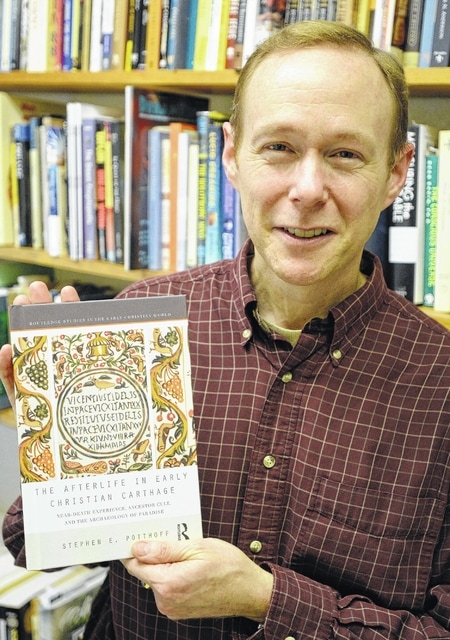
WILMINGTON — Dreams have been considered as a bridge between life and the afterlife since ancient times. Wilmington College’s Dr. Stephen Potthoff’s new book looks at the role of dreams, visions and near-death experiences as they relate to concepts of paradise and the afterlife.
The associate professor of religion and philosophy published The Afterlife in Early Christian Carthage: Near Death Experiences, Ancestor Cult and the Archaeology of Paradise in late 2016. The book ties together Potthoff’s interests in religion, dreams and visionary experiences, and field research he conducted at archaeological digs in Tunisia, North Africa.
This semester, he is teaching the course, “Dreams and World Mythology.”
He said reports depicting the prototype of the near-death experience — a bright light, tunnel and eventual return to earthly consciousness — have been repeated for centuries if not millennia. “Near-death experiences are prevalent in human history and cross culturally. They have played a tremendously important role in giving people hope in the face of death and in imagining the afterlife.”
Potthoff explored Jewish, Greco-Roman and early Christian literature, and discovered a “prevalence” of references to near-death experiences in those cultures. Apocalyptic themes hold a significant place in Jewish and early Christian literature, he said. Indeed, the New Testament “Book of Revelations” contains numerous references to dreams and visions.
Potthoff cited the story of the early Christian martyr, Perpetua, who was arrested, imprisoned and ultimately executed for refusing to worship the Roman emperor as God. She kept a prison journal detailing her “powerful dreams.”
An excerpt from her diary includes the description of a ladder reaching up the heavens: “To the sides of the ladder were attached all sorts of metal weapons: there were swords, spears, hooks, daggers and spikes; so that, if anyone tried to climb up carelessly or without paying attention, he would be mangled and his flesh would adhere to the weapons.”
If that were not daunting enough, a “dragon of enormous size” was stationed at the foot of the ladder.
“Dreams serve as a place where meeting with the Divine takes place — dreams inspire hope,” he said, noting that much of his research centers upon early Christians in Carthage, the ancient city in modern-day Tunisia. “Visions and dreams have been preserved, passed on and presented to the greater Christian world.”
In his course, “Dreams and World Mythology,” Potthoff brings the concept of dreams and visions to the modern day, as class members keep dream journals and discuss one another’s dreams. The students create ways in which to express their dreams such as song, poetry, paintings, collages, dream theatre
and cartoons. “It’s amazing what beautiful work they’ve come up with. This is something human beings have been doing since the beginning of time — our ancient ancestors shared their dream experiences in cave walls.”
Ancient artists often translated near-death experiences in marble catacomb paintings, perhaps depicting a shepherd figure gathering for a meal with community members of the deceased. The modern version of that image might be a funeral service at a cemetery, he added.
Potthoff said much of the book is based upon his doctoral dissertation from 2000, yet he purposely “de-dissertationized” the book to make it more accessible to a larger audience. He hopes it will foster a greater understanding of persons who lay claim to having near-death experiences and those with “powerfully transformative dream experiences,” particularly involving lost loved ones.
“My hope is my work can contribute to fostering a climate of greater openness and acceptance — it’s difficult trying to put into words another form of consciousness,” he said, adding that many are reluctant to share stories of near-death experiences, as they are often met with skepticism or dismissed as hallucinations.
“Near-death experiences are quite common and many persons have taken tremendous inspiration from them,” he said.
Imagery, such as paintings and drawings, permeate the book depicting what Potthoff describes as “the evolution and ongoing transformation of the paradise archetype” experienced in early near-death visions. The artists include Wilmington College senior Linden Ayoki, 2016 alumnus Tiffany Barr, and two area art professors, Craig Dove, adjunct philosophy faculty member at WC, and Bridgette Bogle, an art professor at Sinclair Community College.


